By Trygve S. Aamlid, Norwegian Institute of Bioeconomy Research (NIBIO)
After four winters with excellent survival of greens covered with plastic, Norwegian superintendents and researchers have learned from the winter 2022-23 that impermeable covers are no guarantee against winter damage regardless of weather, grass species and green construction. The winter 2022-23 was extraordinarily long, and together with poor acclimation in the fall, up to 160 days with heavy snow or ice above the plastic was more than many Poa greens could endure. In retrospect, the critical question asked by many Norwegian superintendents is whether greens during this winter would have survived better without covers?
Last winter in ICE-BREAKER
For Nordic golf courses, the winter 2022-23 was not only the toughest winter since 2017-18, but it was also the last winter of ‘ICE-BREAKER’, a project funded by the Scandinavian Turfgrass and Environment Research Foundation (STERF) and the Research Council of Norway. When the project started in 2020, the participating golf courses in the Oslo area already had two years of experiences with impermeable winter covers, and these experiences were so positive that it was decided not to include uncovered greens in the large scale, on-course trials. Instead, we have for the past two winters investigated the need for permeable undercovers and/or sensor-based ventilation under the plastic. Based on the field trials that have been carried out, we are therefore not able to conclude whether survival during this particular winter would have been better without covers.
During April 27-28, 2023, I had the privilege to visit six golf courses around Oslo to find out what went well and what went wrong with the plastic covers during the winter. The purpose of this article is to share my findings with a wider group of superintendents across the Atlantic.
Poor hardening conditions
In preparation for the coming winter, the stakeholders in ICE-BREAKER were gathered at Bærum GC on November 10, 2022. At this meeting everyone agreed that the late fall had been unusually gray with poor hardening conditions. This is confirmed by Figure 1 which shows that the irradiance at NIBIO’s weather station Lier southwest of Oslo during the hardening period from October 15 to November 15 was 24% less in 2022 compared with the four-year average for 2018-2021. At the same time, the average soil temperature during this ‘winter preparation period’ was as much as 1.4°C higher than the year before (Figure 1).
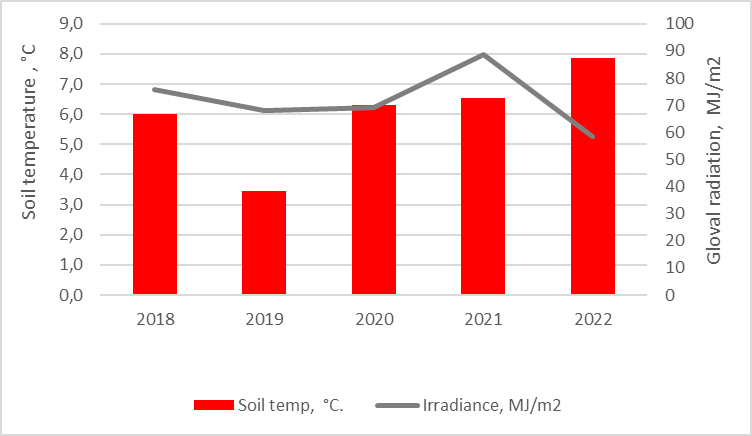
Most golf courses in the Oslo area closed (or ought to close!) for the season around October 15. We want the weather to be bright and sunny until the greens are covered with plastic in November. High irradiance during this period will trigger the grass to maintain a high level of photosynthesis, but with restricted growth due to low temperatures. Such conditions will stimulate the accumulation of carbohydrate reserves in turfgrass crowns, stolons and rhizomes, which is a crucial part of the acclimation process before winter. Towards the end of this period, we also want moderate freezing night temperatures which makes plant membranes more flexible and permeable for water. However, unlike the four previous years, there was not a single night with freezing temperatures during the two first weeks of November 2022!
Long winter with little frost on the greens but plenty of snow and ice
Greens at the six participating golf courses were covered with plastic between November 14-19, 2022. The first snow came on November 21-22, but it was only around 5 cm (2 inches) and not enough to prevent freezing temperatures in the top 10 cm (4 inches) of sand-based greens during the winter’s two coldest weeks from December 5-19. During this cold spell, the sensors measured temperatures down to -5 °C under the plastic sheets (Figure 2a). However, the frost did not penetrate deeply into the rootzones and after more snow had covered the greens, the soil thawed bottom-up on most greens by January (Figure 2a). The maximal snow depth was about 120 cm (4 feet!) and the superintendents were not able to remove the plastic covers until April 18, i.e. after a cover period of 152 days.
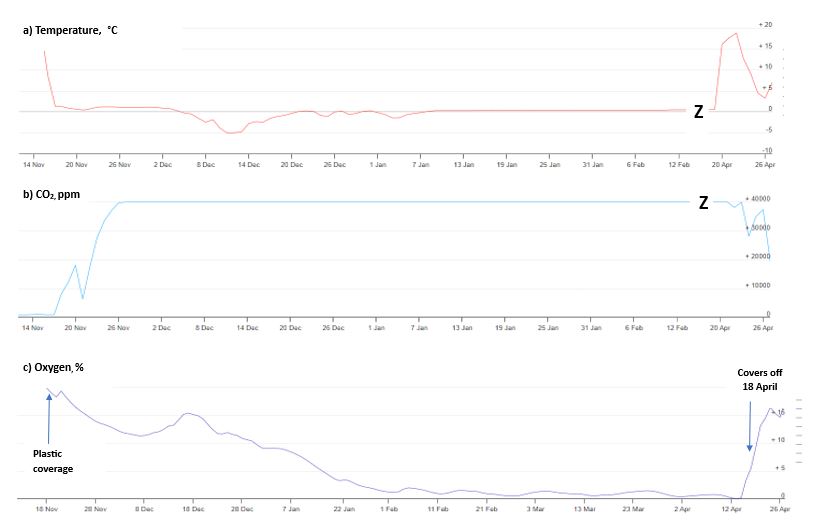
One of the most important characteristics of this winter was that a mild and unstable February with a number of thaw/freeze events was followed by an unusually cold March that delayed snow and ice melt until late April. At NIBIO’s weather station, the mean monthly temperature in February and March were -0.3 and -1.5°C, respectively. A lower mean temperature in March than in February resembles the situation in 2017-18, which was the last winter with severe damages on many Norwegian golf courses.
A good thing about the snow at Asker GC, one of the participating courses, was that it was deep enough to absorb most of the melting water during the thaw events in January and February. Thus, there was little formation of ice over the plastic surface under the snow. This situation was different on other golf courses where the snow depth was only 50-70 cm (19.6 – 27.6 inches) and where a 10-15 cm (3.9 – 5.9 inches) ice layer built up between the plastic and the snow during winter (Figure 3).
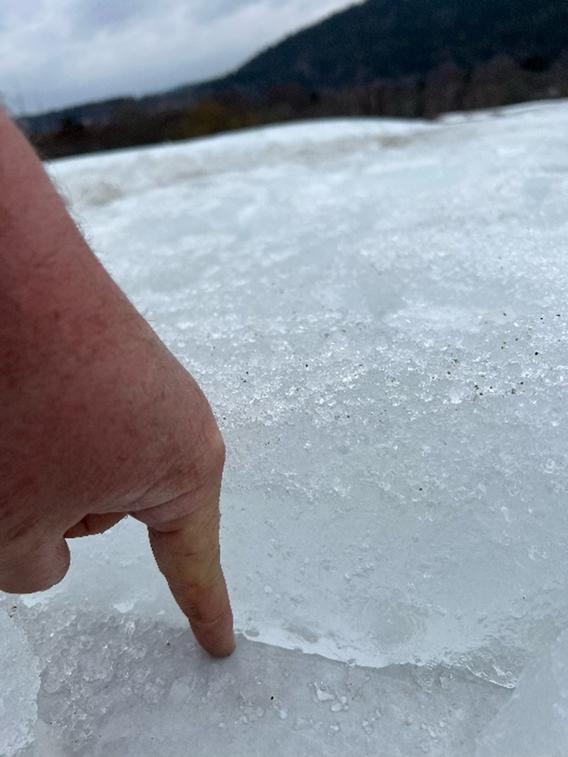
CO2 accumulation and anoxia
The weight of the thick ice and snow layers caused the impermeable covers to be pressed against the green surface with no or very little opportunity for air pockets to form. On greens where drainage pipes had been installed under the plastic for ventilation, the pipes were often pressed into the green surface by the ice and/or snow above it (Figure 4). When combined with a 3-4 week longer cover period than during the previous winters, this heavy layer resulted in oxygen deficiency and the accumulation of CO2 and other toxic and bad-smelling substances under the plastic. On some greens, the O2 concentration was less than 1% for 8-12 weeks (Figure 2c). Such a long O2 concentration over such a long period was never encountered during the past years in ‘ICE-BREAKER’.
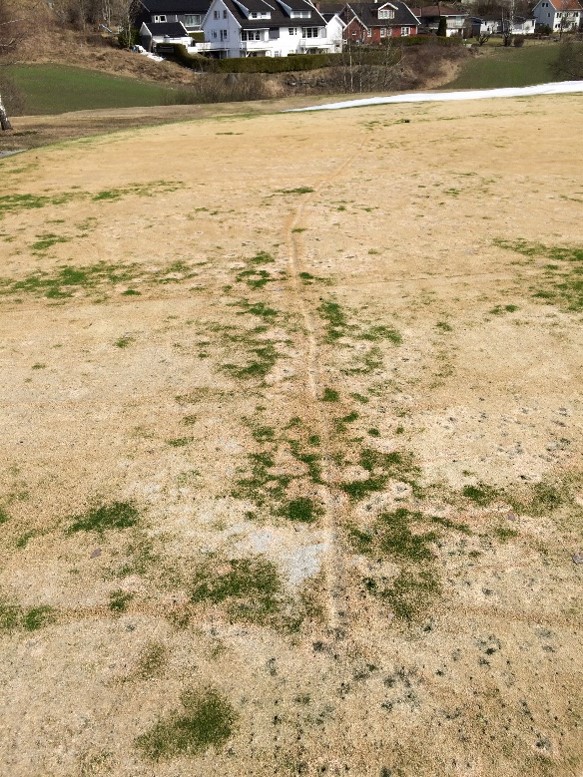
Positive impact of ventilation on some greens
Unlike the situation in Figure 4, we did see a positive effect of ventilation pipes laid out under the plastic in lower areas on several greens. At Holtsmark GC, this was very evident on a practice green where annual bluegrass survived in a 3-4 m (9.8 – 13.1 foot) wide belt on both sides of the ventilation pipe (Figure 5c) but was otherwise dead. Most damage from anoxia at Holtsmark was seen on green 14 which neither had ventilation pipes nor a layer of permeable tarp between the plastic and the grass.
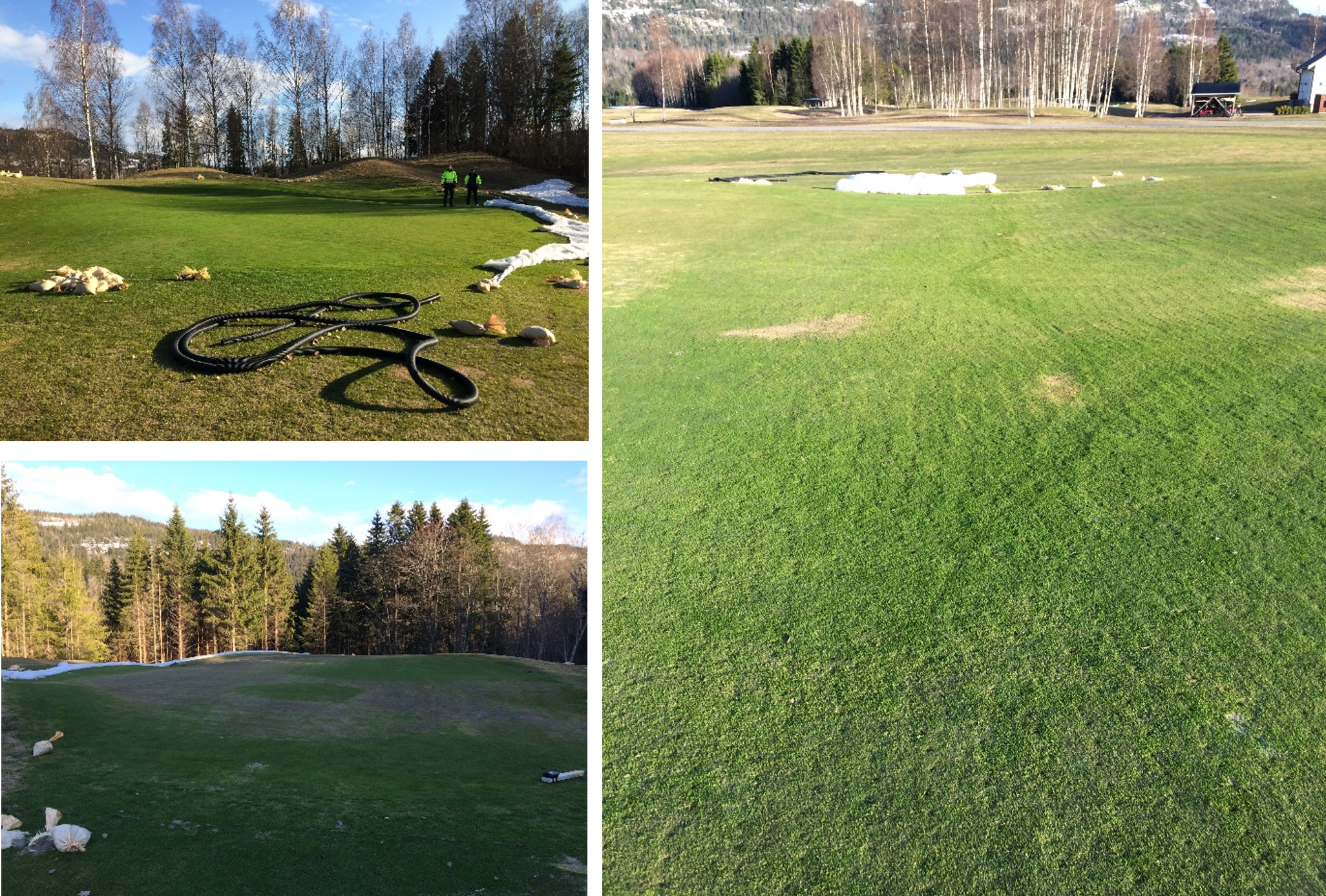
Excellent survival of all covered greens at Oslo GC
Oslo GC is a high budget golf course situated not far from the famous Holmenkollen ski jump. The course has relatively new USGA-specification greens with almost 100% creeping bentgrass and very little annual bluegrass. Oslo also has a Subair system that allows superintendents to ventilate and drain the rootzone for excess water before winter. Given these very favorable conditions, it is perhaps not surprising that that the greens had a 100% winter survival and appeared almost impeccable in spring despite 152 days of plastic coverage (Figure 6).
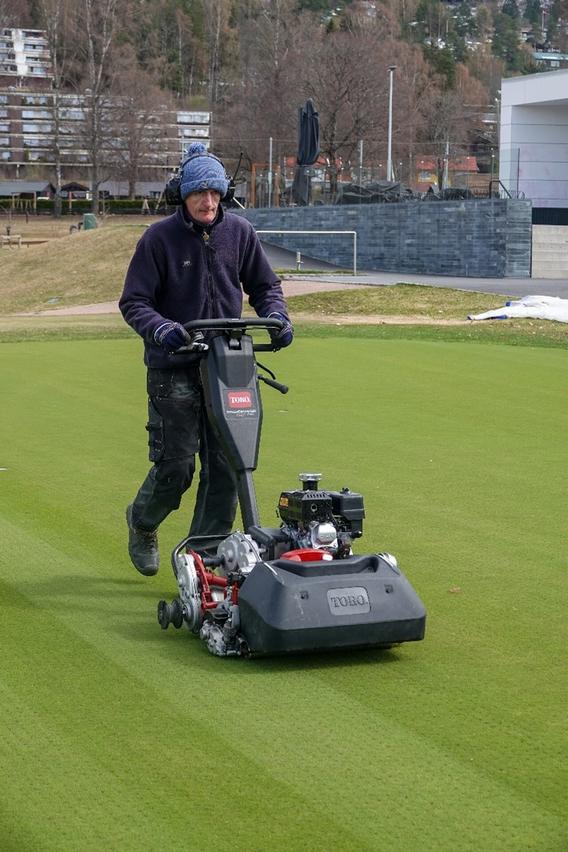
Miklagard GC: Good survival after snow removal during winter
Miklagard GC, about 50 km (31 miles) northeast of Oslo, chose a different strategy than the other courses. Instead of using plastic covers, the superintendents systematically followed the weather forecasts and cleared the snow from all greens and surrounds when mild spells that could potentially result in melting water were predicted. According to the course manager and President of Norwegian Greenkeepers’ Association Duncan Bruce, two superintendents were ‘on call’ for snow removal throughout the winter. The strategy was highly successful during this winter, but a major contributor to success may also have been that Miklagard has no greens with more than 15% annual bluegrass. At the same golf course there was, however, a lot of winter damage on tees and fairways where the snow had not been removed during the winter.
Miklagard’s positive experience with snow removal is consistent with an experiment at NIBIO Apelsvoll, about 100 km (62 miles) further north, during the winter 2021-22. Due to the positive results with plastic covers, we at NIBIO have perhaps not been so good at communicating this alternative to Norwegian golf courses, but repeated snow removal (Table 1) was equally successful as the use of plastic covers on pure creeping bentgrass or slender creeping red fescue putting greens. On the other hand, snow removal throughout winter was not nearly as effective as the use of plastic covers on a pure annual bluegrass green, most likely because annual bluegrass became more vulnerable to freezing damage in the absence of an insulating snow cover. With last winter’s experiences in mind, it is perhaps also pertinent to remind superintendents that the annual bluegrass green in this experiment suffered 61% winter damage even under plastic. This emphasizes that species composition is perhaps even more important than management when it comes to winter survival of putting greens.
![Table 1. Percent winter damage of creeping bentgrass (‘Riptide’ + ‘Independence’), red fescues (mix of Chewings and slender red creeping varieties) and annual bluegrass (local green’s type) as influenced by different conditions / treatments during the winter 2021-22 at NIBIO Apelsvoll Research Center (inland site, 140 km [87 miles] north of Oslo).](/sites/winterturf.umn.edu/files/2023-06/table_1.jpg)
Conclusion
The last winter in the ICE-BREAKER project has given us a more balanced picture of the benefits, but also the risks associated with the use of impermeable plastic covers on golf course putting greens during the winter. With cover periods up to 150 days, annual bluegrass greens are likely to suffer damage from hypoxia / anoxia, particularly if hardening conditions in the fall have been inadequate and there is no or little frost in the soil. Apart from the duration of the cover period, snow and/or ice depth above the covers seem to have an impact on the risk of oxygen deprivation and the accumulation of CO2 and toxic substances under the plastic.
One of the most important lessons learned is that an impermeable plastic layer can not compensate for basic factors such as correctly constructed and well-drained greens with no inlet of water, either on the surface or through the green profile.
Despite the additional but valuable experiences during the last winter, the project as a whole suggests that the careful installation of impermeable plastic covers pays off in four out of five years. The use of a spring tarp to create space and to absorb humidity under the plastic is recommended, and on annual bluegrass greens it may also be insurance to install a ventilation system under the plastic.